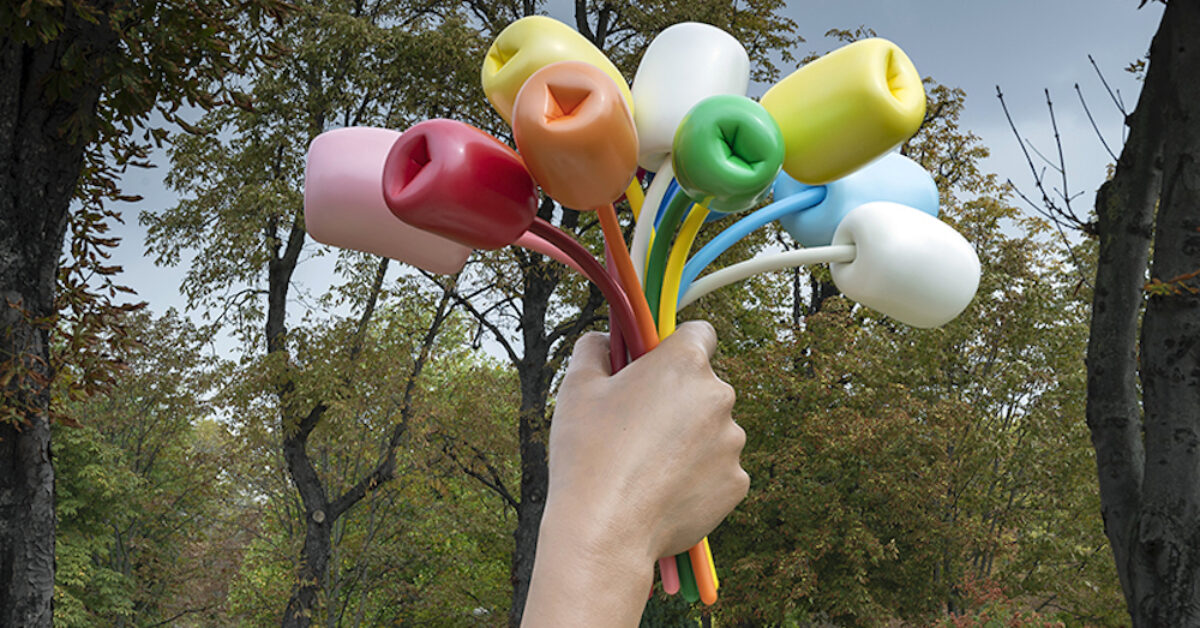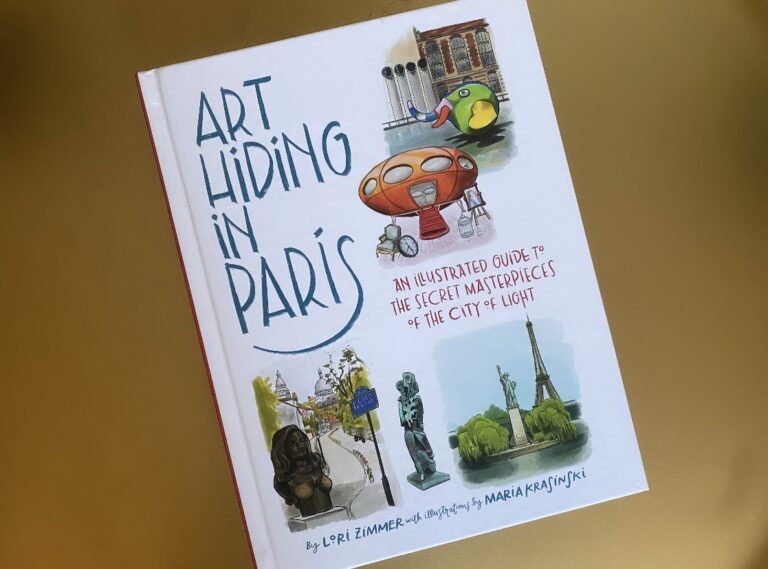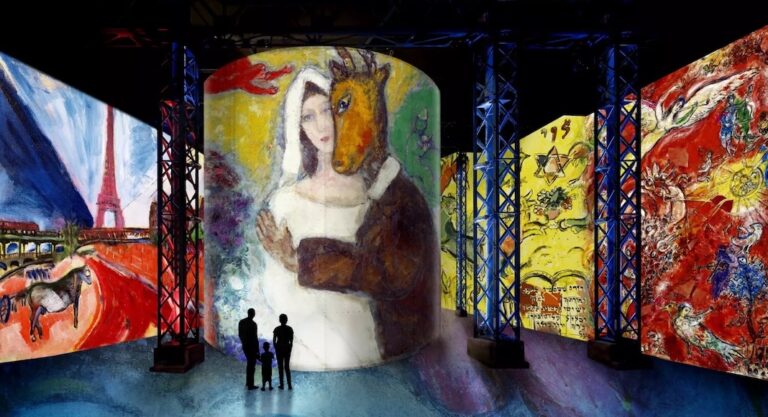Whether or not they like Jeff Koons’ spectacular aestheticism, whether they are sensitive to the generosity of the gesture or struggle to see any link between these navel-shaped flowers and the tragedy of the 2015 attacks, Parisians will now live with Bouquet of Tulips, offered by the American artist in memory of the drama that bloodied their city.
Inaugurated on October 4 near the Petit Palais, the work, despite being less visible in its final spot than it would’ve been on the first chosen location on the concrete of the Palais de Tokyo, does not go unnoticed. Twelve meters high, eight meters wide, 10 meters deep, for a total weight of 60 metric tons… An XXL-sized gift that has given rise to four years of controversy. In January 2018, gallery owner Stéphane Corréard, director of the salon Galeristes, signed a passionate letter published in the daily newspaper Libération to say no to Koons’ gift. Artist Christophe Boltanski, collector and founder of Maison rouge, Antoine de Galbert, architect Dominique Perrault, and many others also signed the letter. Corréard spoke to Le Point to explain his opposition.
Le Point: Why were you, along with several others, so opposed to the first location chosen for Bouquet of Tulips, between the Palais de Tokyo and the Museum of Modern Art?
Stéphane Corréard: Out of respect for the existing heritage, first of all, notably the perspective of the colonnades of the Museum of Modern Art. But above all because for Jeff Koons, this was a fantastic achievement. A monumental work located between the Palais de Tokyo and the Museum of Modern Art, it is the best thing for a contemporary artist. Especially since this type of work is generally very complicated to move. It’s much better than an ephemeral publicity stunt. Ad vitam aeternam, Jeff Koons would be therefore legitimized… All this was decided between three people — the ambassador of the United States, Anne Hidalgo, and the artist himself. And without even the approval of the victims’ associations!
https://www.instagram.com/p/B3NI2-LCsj6/
Under pressure, the location was changed, so the Tulips now stand in the Champs-Élysées garden. It’s a victory, isn’t it?
The pavement around the Palais de Tokyo, whose foundations belong to the state, would have needed to undergo major construction to support the weight of the work, and this was finally refused. What’s surprising is that Jeff Koons has said that he designed these tulips, deciding on their height and proportion, according to their location near the Palais de Tokyo: in situ art, in short. However, the location changed, and nothing [about the piece] has been changed! But this isn’t about criticizing the artist, but rather of denouncing an operation that has not only not been approved by victims’ associations, but above all escapes any public control or consultation, this is the most shocking thing.
But it’s a gift….
So what? Every year, donations made by contemporary artists to the French state are examined by two national acquisition commissions, that of the Fonds national d’art contemporain (FNAC) and that of the Musée national d’Art moderne (MNAM). However, a considerable number of donations are refused! Except that Koons’ donation is made to the Paris City Hall, which does not have such a commission, which accepted [the piece] without debate, without formal consultation. And then Koons only donated the concept. It was private patronage that financed the 3.5 million euros needed to make the tulips, without anyone knowing until the inauguration who the patrons were, which I also find problematic. Because, as you know, patrons receive an important tax credit. In short, it is the City of Paris that accepted [the piece] without question, but the project is based, in a roundabout way, on public finances… so, on you and me. You think that’s normal?
https://www.instagram.com/p/B3MihK_IqRc/
But haven’t all the contemporary creations who have arrived in Parisian public space always suffered the same outcry? The columns of Buren [at the Palais-Royal], the pyramid of the Louvre, the great arch of La Défense, each time there was an attack on their designers….
The works you’re talking about are public commissions. The state orders and finances these objects of art or architecture to install them on sites belonging to the state, these operations do not escape any scrutiny as is the case here. And then, the controversies surrounding these constructions have often pitted ancient and modern, defenders of contemporary art and heritage curators against each other. This is by no means the case here… In the contemporary art world, very few people approve of this Koons project. The survey conducted by the Quotidien de l’art in January 2018 among its readers, who are curators, gallery owners and collectors, was very telling: 98% disapproved of the project. We haven’t even heard the curators of Jeff Koons’ last two exhibitions in France officially defend him, it’s quite revealing.
The letter you signed was terse to the artist, speaking of him as the emblem of an “industrial, spectacular and speculative” art, and evoking a work “unrelated to the tragic events invoked.” But, after all, Les Nymphéas de Monet, offered by the artist to celebrate the armistice of the First World War, had nothing to do with the subject either… And this gift, at the time, was also much decried…
The tulips that Koons donated to France have already been made many times, he did not think of them specifically to commemorate the attacks — except for this hand holding the bouquet, which I find quite morbid. And unlike Monet, who painted it himself, Koons had his idea created by others! He was an exciting artist, but he has changed. Since Made in Heaven (1989), there hasn’t been anymore ambivalence, no mystery in his work, everything depends on the spectacular, the gigantism, the gleaming: his works are eye-catchers, selfie traps. He has hundreds of assistants, his installations are assembled by others in factories located a thousand kilometers from his workshop: how can we not talk about industrial art? Of course, you will tell me that Rubens also had students who painted for him, but Rubens was better than his assistants, who came to learn from him, whereas Koons’ students are paid to do what he would find it hard to do himself! Jeff Koons is, of course, the most expensive artist in the world, but that doesn’t make him the best. To use a vocabulary specific to cinema, let’s call it a blockbuster. Spiderman makes a lot of money, but it’s not necessarily the best film of all time! Basically this donation of the Tulips, indirectly supported by public money, is a bit like if Schwarzenegger made a film to commemorate the Algerian war — but was financed by the National Council for the Arts!
This article was first published on Le Point.






